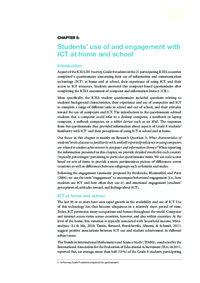Students’ Use of and Engagement with ICT at Home and School |
 |
 Diese Seite wurde seit 10 Jahren inhaltlich nicht mehr aktualisiert.
Unter Umständen ist sie nicht mehr aktuell.
Diese Seite wurde seit 10 Jahren inhaltlich nicht mehr aktualisiert.
Unter Umständen ist sie nicht mehr aktuell.
 Zusammenfassungen
Zusammenfassungen
 As part of the ICILS 2013 survey, Grade 8 students in the 21 participating ICILS countries
completed a questionnaire concerning their use of information and communication
technology (ICT) at home and at school, their experience of using ICT, and their
access to ICT resources. Students answered this computer-based questionnaire after
completing the ICILS assessment of computer and information literacy (CIL).
As part of the ICILS 2013 survey, Grade 8 students in the 21 participating ICILS countries
completed a questionnaire concerning their use of information and communication
technology (ICT) at home and at school, their experience of using ICT, and their
access to ICT resources. Students answered this computer-based questionnaire after
completing the ICILS assessment of computer and information literacy (CIL).
More specifically, the ICILS student questionnaire included questions relating to students’ background characteristics, their experience and use of computers and ICT to complete a range of different tasks in school and out of school, and their attitudes toward the use of computers and ICT. The introduction to the questionnaire advised students that a computer could refer to a desktop computer, a notebook or laptop computer, a netbook computer, or a tablet device such as an iPad. The responses from this questionnaire thus provided information about aspects of Grade 8 students’ familiarity with ICT1 and their perceptions of using ICT at school and at home.
Our focus in this chapter is mainly on Research Question 3: What characteristics of students’ levels of access to, familiarity with, and self-reported proficiency in using computers are related to student achievement in computer and information literacy? When reporting the information presented in this chapter, we provide detailed results for each country (typically percentages) pertaining to particular questionnaire items. We use scale scores based on sets of items to provide a more parsimonious picture of differences across countries as well as differences between subgroups such as females and males.
 Dieses Kapitel erwähnt ...
Dieses Kapitel erwähnt ...
 Fragen KB IB clear | Wie nutzen Kinder und Jugendliche Medien und ICT? |
 Begriffe KB IB clear |  ICILS
, ICILS
,  Schule Schule school school
|
 Dieses Kapitel erwähnt vermutlich nicht ...
Dieses Kapitel erwähnt vermutlich nicht ... 
 Nicht erwähnte Begriffe | ICILS 2018, LehrerIn, Unterricht |
 1 Erwähnungen
1 Erwähnungen 
- Students, Computers and Learning - Making the Connection (OECD Organisation for Economic Co-operation and Development) (2015)


 Volltext dieses Dokuments
Volltext dieses Dokuments
 Anderswo suchen
Anderswo suchen 
 Beat und dieses Kapitel
Beat und dieses Kapitel
Beat hat Dieses Kapitel während seiner Zeit am Institut für Medien und Schule (IMS) ins Biblionetz aufgenommen. Beat besitzt kein physisches, aber ein digitales Exemplar. (das er aber aus Urheberrechtsgründen nicht einfach weitergeben darf). Aufgrund der wenigen Einträge im Biblionetz scheint er es nicht wirklich gelesen zu haben. Es gibt bisher auch nur wenige Objekte im Biblionetz, die dieses Werk zitieren.








 , 316 kByte)
, 316 kByte)  Biblionetz-History
Biblionetz-History